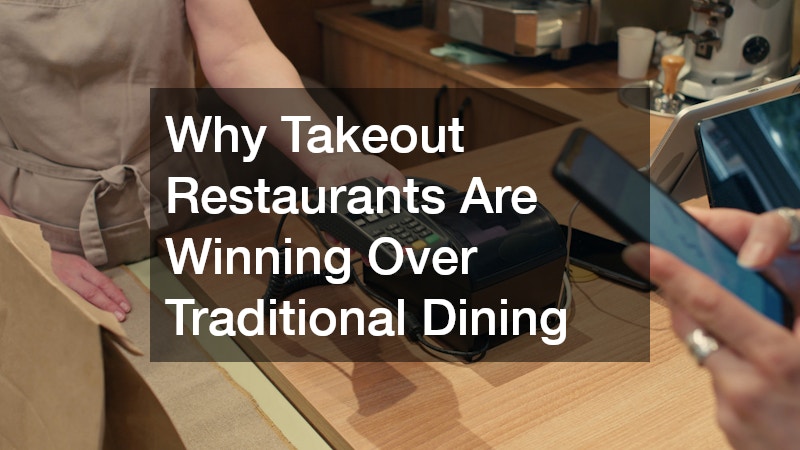
In recent years, dining habits have undergone a dramatic shift. The rise of technology, busy lifestyles, and changing consumer expectations has led to an increase in the popularity of take-out restaurants. What was once considered a convenience option has now become a primary choice for millions of people who prioritize speed, variety, and comfort without sacrificing quality. As traditional dining experiences face new challenges, take-out restaurants are capitalizing on these opportunities and reshaping the way people enjoy food.
Convenience Is King
One of the main reasons take-out restaurants are winning over traditional dining is convenience. In today’s fast-paced world, consumers often do not have the time to spend an hour or more at a restaurant table.
Take-out restaurants provide a solution by allowing customers to enjoy restaurant-quality meals at home, at work, or even on the go. This convenience is especially appealing to busy professionals, parents juggling schedules, and students who need a quick meal between classes. The ability to fit a quality meal seamlessly into a hectic day has become a key factor in dining choices.
Mobile apps and online ordering platforms have made the process even simpler. Customers can browse menus, customize their orders, and pay digitally, all in a matter of minutes. This ease of access appeals to individuals and families alike, reducing the friction that comes with traditional dining. For many, take-out restaurants are no longer just a backup option—they are the preferred method for enjoying meals, especially during busy weekdays or social events. Beyond convenience, takeout allows people to enjoy a wider variety of meal options without leaving the comfort of their own home, offering flexibility that traditional dining rarely provides.
Variety and Customization
Another factor driving the growth of take-out restaurants is the variety and customization they offer. While traditional dining can be limited by seating capacity, menu size, or service hours, take-out restaurants often have extensive menus designed to cater to a wide range of tastes and dietary preferences. From vegan and gluten-free options to international cuisines, the variety available for takeout can surpass what some traditional restaurants offer. This abundance of choice ensures that everyone—from picky eaters to food enthusiasts—can find something that appeals to them.
Customization is also easier with takeout orders. Many platforms allow diners to make specific requests, whether it’s adjusting spice levels, swapping ingredients, or selecting portion sizes. This level of personalization enhances the customer experience and fosters a sense of control over their meal. As consumers increasingly seek options tailored to their lifestyle and preferences, take-out restaurants continue to meet this demand in ways traditional dining sometimes cannot.
Technology and Delivery Innovation
Technology has played a pivotal role in the rise of take-out restaurants. The integration of delivery services, user-friendly apps, and advanced logistics has transformed the way food reaches customers. Services like app-based ordering, real-time tracking, and contactless delivery have made takeout both safe and reliable, especially in a post-pandemic world where hygiene and convenience are paramount.
Moreover, many take-out restaurants leverage technology to improve efficiency and customer satisfaction. From AI-driven recommendations to streamlined kitchen operations, technology allows these businesses to deliver consistently high-quality meals quickly. Traditional dining experiences, while enjoyable, often cannot match the speed and adaptability offered by tech-enabled takeout services. Additionally, data analytics helps restaurants anticipate popular items and peak ordering times, ensuring faster preparation and better resource management.
Cost-Effectiveness and Accessibility
Affordability is another reason take-out restaurants are gaining an edge over traditional dining. Dining out often comes with additional costs, such as tipping, valet, or higher menu prices due to overhead. Takeout eliminates many of these expenses, making it more accessible to a wider audience. Customers can enjoy a similar dining experience at a lower cost, without compromising on quality.
Accessibility extends beyond cost. Take-out restaurants cater to individuals who may find it challenging to dine out, such as those with mobility issues, busy parents, or people working late shifts. With easy-to-use delivery platforms, a broader demographic can access a wide range of cuisines and dining options that were once limited to in-person experiences.
The surge of take-out restaurants is not a temporary trend—it reflects a fundamental shift in consumer behavior and expectations. Convenience, variety, technological innovation, and cost-effectiveness have all contributed to their growing dominance over traditional dining. While traditional restaurants continue to offer valuable social and experiential aspects, take-out restaurants meet the needs of a modern, fast-paced, and diverse audience in ways that dining in often cannot.
As lifestyles continue to evolve, it is clear that take-out restaurants will play an increasingly significant role in the culinary landscape. For businesses, understanding this shift is critical, as the demand for flexible, high-quality, and accessible food options shows no signs of slowing down. In the battle for customer preference, take out restaurants have proven themselves not just a viable alternative, but a preferred choice for millions of diners worldwide.

